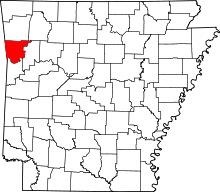Dyer, Arkansas
| Dyer, Arkansas | |
|---|---|
| City | |
|
Outskirts of Dyer with Arkansas River in the background, July 2005 | |
 Location in Crawford County and the state of Arkansas | |
| Coordinates: 35°29′40″N 94°8′19″W / 35.49444°N 94.13861°WCoordinates: 35°29′40″N 94°8′19″W / 35.49444°N 94.13861°W | |
| Country | United States |
| State | Arkansas |
| County | Crawford |
| Area | |
| • Total | 2.6 sq mi (6.8 km2) |
| • Land | 2.6 sq mi (6.8 km2) |
| • Water | 0 sq mi (0 km2) |
| Elevation | 430 ft (131 m) |
| Population (2010) | |
| • Total | 876 |
| • Density | 335/sq mi (129.5/km2) |
| Time zone | Central (CST) (UTC-6) |
| • Summer (DST) | CDT (UTC-5) |
| ZIP code | 72935 |
| Area code(s) | 479 |
| FIPS code | 05-20200 |
| GNIS feature ID | 0076832 |
Dyer is a city[1] in Crawford County, Arkansas, United States. It is part of the Fort Smith, Arkansas-Oklahoma Metropolitan Statistical Area. The population was 876 at the 2010 census.[2]
Geography
Dyer is located in southeastern Crawford County at 35°29′40″N 94°8′19″W / 35.49444°N 94.13861°W (35.494532, -94.138541),[3] in the Arkansas River valley. U.S. Route 64 passes through the community, leading west 5 miles (8 km) to Alma and 13 miles (21 km) to Van Buren, the county seat, and east 5 miles (8 km) to Mulberry. Interstate 40 passes through the northern part of Dyer but does not have a direct exit for the city; the nearest access is from Exit 20 in the western part of Mulberry.
According to the United States Census Bureau, Dyer has a total area of 2.6 square miles (6.8 km2), all land.[2]
Demographics
| Historical population | |||
|---|---|---|---|
| Census | Pop. | %± | |
| 1900 | 343 | — | |
| 1910 | 433 | 26.2% | |
| 1920 | 609 | 40.6% | |
| 1930 | 425 | −30.2% | |
| 1940 | 513 | 20.7% | |
| 1950 | 398 | −22.4% | |
| 1960 | 450 | 13.1% | |
| 1970 | 486 | 8.0% | |
| 1980 | 608 | 25.1% | |
| 1990 | 502 | −17.4% | |
| 2000 | 585 | 16.5% | |
| 2010 | 876 | 49.7% | |
| Est. 2015 | 860 | [4] | −1.8% |
2014 Estimate[6] | |||
As of the census[7] of 2000, there were 585 people, 230 households, and 163 families residing in the town. The population density was 86.9/km² (225.3/mi²). There were 248 housing units at an average density of 36.8/km² (95.5/mi²). The racial makeup of the town was 96.24% White, 0.17% Black or African American, 1.20% Native American, 0.85% Asian, and 1.54% from two or more races. 0.17% of the population were Hispanic or Latino of any race.
There were 230 households out of which 30.4% had children under the age of 18 living with them, 61.3% were married couples living together, 5.2% had a female householder with no husband present, and 28.7% were non-families. 23.9% of all households were made up of individuals and 13.5% had someone living alone who was 65 years of age or older. The average household size was 2.54 and the average family size was 3.06.
In the town the population was spread out with 25.5% under the age of 18, 6.0% from 18 to 24, 29.1% from 25 to 44, 23.6% from 45 to 64, and 15.9% who were 65 years of age or older. The median age was 39 years. For every 100 females there were 93.1 males. For every 100 females age 18 and over, there were 98.2 males.
The median income for a household in the town was $23,438, and the median income for a family was $28,500. Males had a median income of $28,523 versus $21,500 for females. The per capita income for the town was $13,206. About 22.6% of families and 34.1% of the population were below the poverty line, including 52.7% of those under age 18 and 32.1% of those age 65 or over.
History
The town of Dyer was named after Joel Dyer, owner of the stagecoach relay station on the Wire Road.
Famous residents
Controversial and radical minister Tony Alamo once claimed Dyer to be the home of his organization, although it is commonly referred to as "Alma" in most media reports. (Dyer is located about 5 miles (8 km) east of Alma.) Alamo's compound, which included a church, school, round-the-clock guards and much more, served as a meeting place for his organization, Alamo Ministries.
In 2008 Alamo was arrested in Flagstaff, Arizona, after a raid of his new compound in Fouke, located in southwest Arkansas. He was charged with violating the Mann Act for allegedly transporting minors across state lines for illegal purposes, i.e. sexual acts.
References
- ↑ Local.Arkansas.gov - Dyer, retrieved September 3, 2012
- 1 2 "Geographic Identifiers: 2010 Demographic Profile Data (G001): Dyer city, Arkansas". U.S. Census Bureau, American Factfinder. Retrieved June 18, 2014.
- ↑ "US Gazetteer files: 2010, 2000, and 1990". United States Census Bureau. 2011-02-12. Retrieved 2011-04-23.
- ↑ "Annual Estimates of the Resident Population for Incorporated Places: April 1, 2010 to July 1, 2015". Retrieved July 2, 2016.
- ↑ "Census of Population and Housing". Census.gov. Retrieved June 4, 2015.
- ↑ "Annual Estimates of the Resident Population for Incorporated Places: April 1, 2010 to July 1, 2014". Retrieved June 4, 2015.
- ↑ "American FactFinder". United States Census Bureau. Retrieved 2008-01-31.

